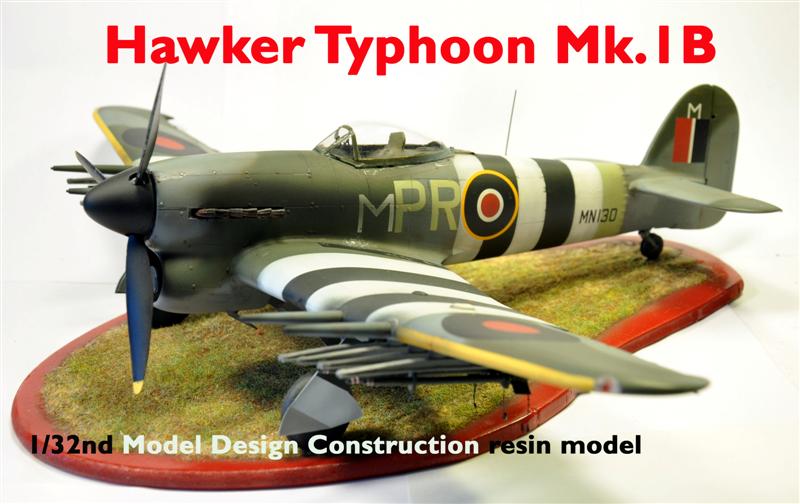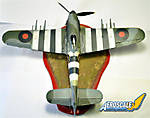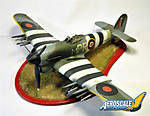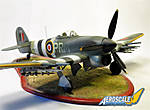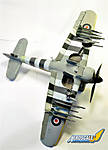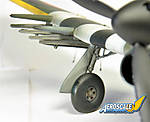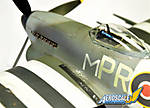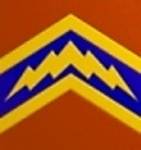1⁄32Hawker Typhoon Mk.1B
3
Comments
Hawker Typhoon Mk.1B
The Typhoon was a British single-seat fighter-bomber, produced by Hawker Aircraft starting in 1941. Although it was intended to be a replacement for the Hawker Hurricane in the interceptor role, the Typhoon underwent a long gestation period, eventually evolving into one of the Second World War's most successful ground-attack aircraft. In RAF slang, the Typhoon was nicknamed the Tiffy.Specifications
General characteristicsCrew: One
Length: 31 ft 11.5 in (9.73 m)
Wingspan: 41 ft 7 in (12.67 m)
Height: 15 ft 4 in (4.66 m)
Wing area: 249 ft² (23.13 m²)
Empty weight: 9,800 lb (4,445 kg)
Loaded weight: 11,400 lb (5,170 kg)
Max takeoff weight: 13,980 lb (6,340 kg)
Powerplant: 1× Napier Sabre IIC liquid-cooled H-24, 2,260 hp (1,685 kW)
Performance
Maximum speed: 405 mph (650 km/h) at 18,000 ft (5,485 m)
Stall speed: 88 mph () IAS with flaps up
Range: 610 mi (980 km)
Service ceiling: 34,000 ft (10,400 m)
Rate of climb: 2,630 ft/min (13.4 m/s)
Wing loading: 45.8 lb/ft² (223.5 kg/m²)
Power/mass: 0.20 hp/lb (0.33 kW/kg)
Armament
4 × 20 mm Hispano cannons
2 × 1,000 lb (454 kg) bombs
8 × RP-3 (60 lb) unguided air-to-ground rockets
Some Interesting facts
Nearly all of the 3,330 Hawker Typhoons were built at the Gloster factory.The 20 alloy "fishplates" that were riveted externally across the rear fuselage transport joint was a measure designed to stop the loss of the entire tail sections of some early aircraft; this occurred mainly during high-speed dives. It was eventually determined to be caused by a combination of factors, including harmonic vibration, which could lead to early metal fatigue, and a weak transport join just forward of the horizontal tail unit.
The first squadron to equip with the Typhoon was No 56 Sqn, based at Duxford, which were flying Hawker Hurricanes MkIIBs.
The first two combat losses of the Typhoon were the result of friendly fire when two Canadian Spitfires, scrambled to intercept the same planes the Typhoons had been scrambled to intercept, shot down both aircraft over the English Channel. The profile of the Typhoon resembled a Fw 190 from some angles, and this similarity caused more than one "friendly fire" incident with Allied anti-aircraft units and other fighters. This led to Typhoons being marked up with high visibility black and white stripes under the wings, a precursor of the markings applied to all Allied aircraft on D-Day.
It was not until 1943 that the various problems with the airframe and engine had finally started to be worked out of the system. By this time the need for a pure fighter was no longer important and the design was converted into a fighter-bomber. The powerful engine allowed the plane to carry a massive load of (eventually) up to two 1,000 lb (450 kg) bombs, equal to the light bombers of only a few years earlier. The bomb-equipped aircraft were nicknamed, "Bombphoons", and entered service with No. 181 Squadron, formed in September 1942.
Although the rocket projectiles carried by the Typhoons were inaccurate and took some considerable skill to aim properly and allow for the drop after firing, the sheer firepower of just one Typhoon was equivalent to a destroyer's broadside.
The top scoring Typhoon ace was Group Captain John Robert Baldwin (609 Squadron and Commanding Officer 198 Squadron, 146(Typhoon) Wing and 123(Typhoon) Wing), who claimed 15 aircraft shot down during 1942–44. Some 246 Axis aircraft were claimed by Typhoon pilots during the war.
The first Typhoon to be flown by the Luftwaffe was EJ956 SA-I of 486(NZ) Sqn. On 23 March 1943 two aircraft flown by F/O Smith and F/S Mawson were on a "Rhubarb" over France. Just as they were crossing the coast at low altitude Mawson's Typhoon was hit by light flak. He managed to belly-land in a field near Cany-Barville but before he could destroy the aircraft it was surrounded by German troops. The Typhoon was repaired and test flown at Rechlin (a German equivalent to RAE Farnborough) and later served as T9+GK with "Zirkus Rosarius". EJ956 overturned and was written off during a forced landing near Meckelfield, 10 August 1944.
Hawker developed an improved version of the Typhoon, the Typhoon II but the differences between it and the Mk I were so great that it was effectively a different plane, and became known as the Hawker Tempest.
Once the war in Europe was over the RAF was quick to remove the aircraft from front line squadrons; by mid-1946 the Typhoon was no longer in use as an operational aircraft, with many of the wartime Typhoon units either being disbanded or re-numbered.
Only one complete Hawker Typhoon still survives - MN235 - and it is on display at the RAF Museum in Hendon, North London.
The model
1/32nd scale resin model by Model Design Construction. Painted with Xtracyrilics and Tamiya paints. Markings for 609 Sqn.Comments
Nice job, Andy. An angry looking aircraft that seems to be able to deal out some punishment. Interesting with a little history on the type.
Thanks for sharing
APR 06, 2009 - 03:02 AM
Nice one Andy.
Shame you couldnt make Cosford yesterday. I think if I had seen this up close I would definately have bought one,,so you not being there actually saved me quite a few quid
Nige
APR 06, 2009 - 03:26 AM
Thanks guys, it is one fierce looking bird (much like my Beloved ).
I like spending your money so I shall make sure it attends a show that your at .
Andy
APR 06, 2009 - 07:28 AM
Copyright ©2021 by Andy Brazier. Images also by copyright holder unless otherwise noted. The views and opinions expressed herein are solely the views and opinions of the authors and/or contributors to this Web site and do not necessarily represent the views and/or opinions of AeroScale, KitMaker Network, or Silver Star Enterrpises. Images also by copyright holder unless otherwise noted. Opinions expressed are those of the author(s) and not necessarily those of AeroScale. All rights reserved. Originally published on: 2009-04-04 00:00:00. Unique Reads: 19489




